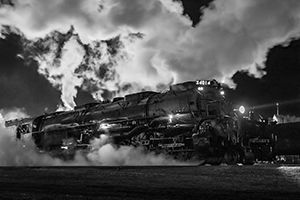
In 2019 Chris Philipson of Eastbourne Photographic Society and his wife made a return visit to the US and embarked on a 1,000 mile journey. In a debut presentation he showed us photographs of his trip but not in the form of a travelogue but by focussing on four themes.
He is fascinated by railways and began with images of a restored Big Boy steam engine used on the Union Pacific Railway. At 132 feet long and weighing 585 tons it was a big beast. This is one of eight surviving engines today and was restored in Cheyenne, Wyoming for the 150th anniversary of the transcontinental railway. Steam trains ceased in the US between 1955 and 1960 yet some of the paraphernalia of steam remains to be photographed today such as a water tower and Medicine Bow Depot with its red shingle roof and white walls conserved as a national historic building. Trains 12,000 feet long with locomotives front, centre and rear featured prominently.
Greater Yellowstone was next with snow as late as May and cottonwood trees, naturally white in the Spring, looking like they were covered with hoar frost. The sage brush too looked white. Created in 1872 Yellowstone National Park's diversity of natural wealth includes the hydrothermal features, wildlife, vegetation, lakes, and geologic wonders like the Grand Canyon of the Yellowstone River. Chris was able to photograph many of these including bison and elk and the Grand Teuton mountains. Even in May Jackson Lake was frozen and snow showers could be photographed in Snake Valley. Chris showed the many colours of the sulphur springs, mud volcano and eerie travertine deposits on cascades of hot water.
The High Plains are part of the Great Plains that extend from Saskatchewan in Canada to Texas to the west of the Mississippi River and east of the Rocky Mountains. Chris's exploration was in Colorado, South Dakota and Nebraska. His approach was to convert images to monochrome to bring out the features of the area when colour did not do it justice. Big skies were a regular feature, as were abandoned cars, lone homesteads, schools and churches long abandoned. He illustrated Deerfield, a town created for African Americans from 1910. The Great Depression led to its decline with only 12 residents by 1940. Since 1998 it has been conserved as a national heritage site but the remaining buildings are little more than a gas station, a diner, and the founder's home. Other abandoned buildings such as grain elevators, gold mines and wind pumps litter the landscape. A tepee frame and a lone native American lodge testify to the treatment of the indigenous population explored in Bury my heart at Wounded Knee. Remnants of the Oregon Trail, the waggon train route to the West remain. Towns with colourful names like Geraldine and Winifred were also illustrated along with images of lenticular clouds.
The Oregon Trail also featured in the final section illustrating the devastation caused by the abandonment of the Milwaukee railroad in the 1980s. Chimney Rock in Nebraska was a way marker on this Trail and the Mormon Trail. As the railroad went so did the people and as in the High Plains isolated buildings remain in widespread locations. The Iliad school with its single classroom and teacher's one room accommodation lies miles from anywhere. Carhenge in Alliance, Nebraska resembles Stonehenge but with cars acting as the stones and painted grey was one location Chris visited. Twodot, Montana was another town founder in 1900 that now has just 26 residents and some historic buildings. Natural features such as Square Butte, Montana and Pawnee Buttes, Colorado can be seen for miles around. The Wind River flowing through Red Rock Canyon and Freemont Lake completed the show.
